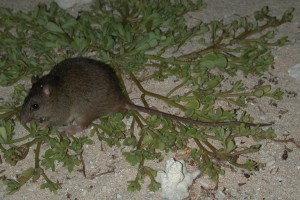An Australian Rodent Has Gone Extinct Due to Climate Change. Are Humans Next?
 The Bramble Cay melomys (photo by Rebecca Diete and Luke Leung/University of Queensland)
The Bramble Cay melomys (photo by Rebecca Diete and Luke Leung/University of Queensland) If you Google Image search the Bramble Cay melomys, the results will show a rather unremarkable looking rat. With its large, black, shiny eyes and little pointed nose with long whiskers, it seems cute, though perhaps not an animal you’d wish to have as an uninvited guest in your house. You may assume there’s nothing particularly special at all about this little rodent. Unfortunately, outside of Google Image search and other forms of image recordkeeping, no one will ever be able to see a Bramble Cay melomys again. The devastating effects of global warming on their environment have pushed this species to extinction, and the Bramble Cay melomys won’t be the last creature claimed by climate change.
Declared the first mammalian species driven to extinction by climate change, the Bramble Cay melomys inhabited the northernmost point in Australia and had long been considered one of the most threatened species on the planet. As the temperature of our planet’s atmosphere has increased and sea levels have risen, increased flooding destroyed the rodent’s habitat. Scientists attribute these high tides directly to human-caused climate change and warn that many other species unique to Australia could also soon go extinct because of global warming’s destruction of their ecosystems. There’s a slight chance that Bramble Cay melomys may be living in Papua New Guinea, but as they’ve never been found there, researchers aren’t hopeful about discovering evidence contradicting the species’ demise.

The Bramble cay melomys (photo by Ian Bell, EHP, State of Queensland)
While the Bramble Cay melomys may be the first casualty of climate change, a startling number of other species are severely threatened or endangered because of the havoc humanity is wreaking on the planet. About a month ago, the North American Bird Conservation Initiative released a report stating that 37 percent of migratory birds are at risk of extinction due to climate change. Polar bears, which have long been the poster animals for climate-induced destruction, are radically changing their feeding and hunting behaviors, that is, if they aren’t starving to death. Bees and butterflies are also vulnerable to the effects of climate change, along with the ringed seal, golden bowerbird, American pika, orange-spotted filefish, Emperor penguin, golden plover, and numerous other species of animals and plants.
Of grave concern is the potential demise of our own species. Seven island nations currently at sea level are facing the most pressing consequences of climate change, with increasingly severe flooding and erratic weather patterns that threaten the life and health of their populations. As these conditions worsen, more and more people around the globe will become displaced as their homes are swept away by the sea. Meanwhile, increasing global temperatures are creating drought and famine in Africa, and the political instability in countries such as Syria and Iraq is exacerbated by the drying out of arable land. Even the US Department of Defense has declared climate change a security risk because of its effects on food insecurity and displacement, which ultimately lead to political and economic instability. Climate change will also disproportionately affect poor individuals, who are more likely to bear the burdens of food insecurity, destruction of their homes, and health problems caused by climate change. Climate change will also not only increase the inequality between nations but also exacerbate existing inequalities within nations as more people struggle over scarcer and scarcer resources. Adding to these injustices, a report by Oxfam found that 50 percent of the world’s carbon emissions are produced by the world’s richest 10 percent. Unfortunately, the poor will be subjected to far more brutal and harmful effects of climate change than the rich, who have more resources to insulate themselves from these disasters.
These disastrous consequences of climate change for our own species and for the entire planet aren’t projections into a far-off future. They are already happening and will only continue to grow worse in the coming decades. The time for action on climate change is now. Doing our individual part to reduce our carbon footprints by reducing our consumption and modifying our lifestyles is helpful, but individual action alone is simply not enough to tackle the systemic causes of climate change. With a global economic system more concerned about short-term profits than long-term sustainability, businesses and governments have little incentive to curb carbon emissions or enact sustainable practices that will pay off long-term but won’t see immediate returns. Yet scientists around the world are urging us to act now and act quickly before global temperatures rise any further.
The humanist movement has long backed the scientists and fought against the misinformation spread against climate change deniers, who are often allied with the religious right. It’s time we doubled down on our efforts to convince other Americans that there’s no debate;the data show that climate change is happening, and it’s caused by human action. Furthermore, in its advocacy efforts around this issue, the humanist movement must step outside its individual silo and work with other groups focused on combatting climate change. Some of these allies are obvious, such as environmentalist groups, but unions, as well as organizations working in hunger-relief, human rights, economic inequality, and healthcare are also broadening their activities to take on climate change.
A warming planet affects us all, so we all must ban together to form a movement too big for the businesses, the religious right, and the government to ignore. It’s too late for the Bramble Cay melomys, but there’s still time for us to save our own species, even if time is rapidly running out.
